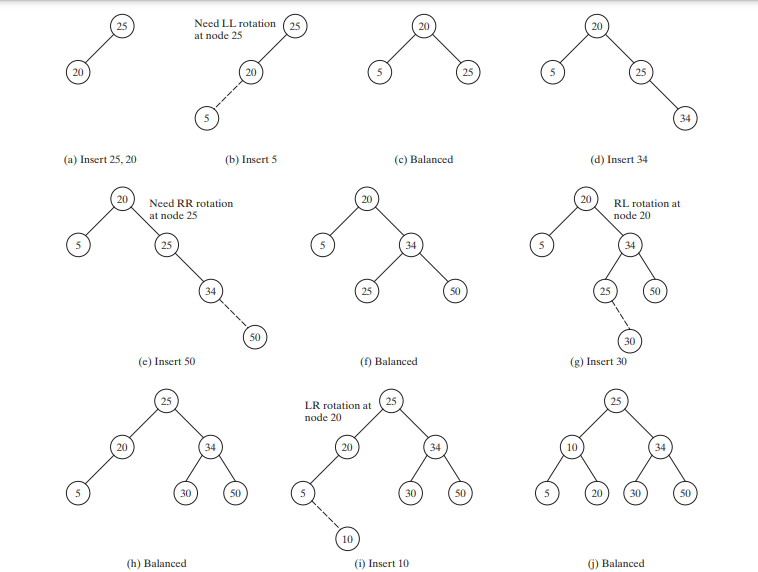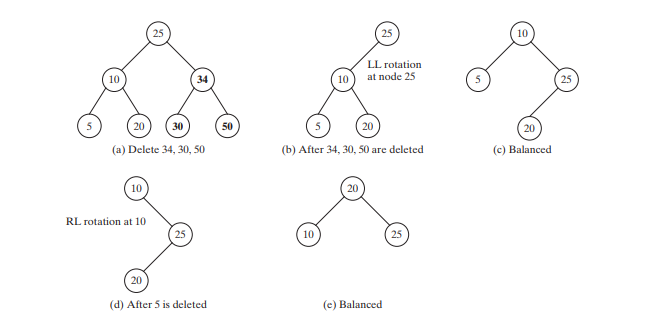Testing the AVLTree Class
This section gives an example of using the AVLTree class. The code below gives a test program. The program creates an AVLTree initialized with an array of the integers 25, 20, and 5 (lines 7), inserts elements in lines 11–20, and deletes elements in lines 24–30. Since AVLTree is a subclass of BST and the elements in a BST are iterable, the program uses a foreach loop to traverse all the elements in lines 35–37.
package demo;
public class TestAVLTree {
public static void main(String[] args) {
// Create an AVL tree
AVLTree<Integer> tree = new AVLTree<>(new Integer[]{25, 20, 5});
System.out.print("After inserting 25, 20, 5:");
printTree(tree);
tree.insert(34);
tree.insert(50);
System.out.print("\nAfter inserting 34, 50:");
printTree(tree);
tree.insert(30);
System.out.print("\nAfter inserting 30");
printTree(tree);
tree.insert(10);
System.out.print("\nAfter inserting 10");
printTree(tree);
tree.delete(34);
tree.delete(30);
tree.delete(50);
System.out.print("\nAfter removing 34, 30, 50:");
printTree(tree);
tree.delete(5);
System.out.print("\nAfter removing 5:");
printTree(tree);
System.out.print("\nTraverse the elements in the tree: ");
for (int e: tree) {
System.out.print(e + " ");
}
}
public static void printTree(BST tree) {
// Traverse tree
System.out.print("\nInorder (sorted): ");
tree.inorder();
System.out.print("\nPostorder: ");
tree.postorder();
System.out.print("\nPreorder: ");
tree.preorder();
System.out.print("\nThe number of nodes is " + tree.getSize());
System.out.println();
}
}
After inserting 25, 20, 5:
Inorder (sorted): 5 20 25
Postorder: 5 25 20
Preorder: 20 5 25
The number of nodes is 3
After inserting 34, 50:
Inorder (sorted): 5 20 25 34 50
Postorder: 5 25 50 34 20
Preorder: 20 5 34 25 50
The number of nodes is 5
After inserting 30
Inorder (sorted): 5 20 25 30 34 50
Postorder: 5 20 30 50 34 25
Preorder: 25 20 5 34 30 50
The number of nodes is 6
After inserting 10
Inorder (sorted): 5 10 20 25 30 34 50
Postorder: 5 20 10 30 50 34 25
Preorder: 25 10 5 20 34 30 50
The number of nodes is 7
After removing 34, 30, 50:
Inorder (sorted): 5 10 20 25
Postorder: 5 20 25 10
Preorder: 10 5 25 20
The number of nodes is 4
After removing 5:
Inorder (sorted): 10 20 25
Postorder: 10 25 20
Preorder: 20 10 25
The number of nodes is 3
Traverse the elements in the tree: 10 20 25
Figure below shows how the tree evolves as elements are added to the tree. After 25 and 20 are added, the tree is as shown in Figure below (a). 5 is inserted as a left child of 20, as shown in Figure below (b). The tree is not balanced. It is left-heavy at node 25. Perform an LL rotation to result in an AVL tree, as shown in Figure below (c).
After inserting 34, the tree is shown in Figure below (d). After inserting 50, the tree is as shown in Figure below (e). The tree is not balanced. It is right-heavy at node 25. Perform an RR rotation to result in an AVL tree, as shown in Figure below (f).
After inserting 30, the tree is as shown in Figure below (g). The tree is not balanced. Perform an RL rotation to result in an AVL tree, as shown in Figure below (h).
After inserting 10, the tree is as shown in Figure below (i). The tree is not balanced. Perform an LR rotation to result in an AVL tree, as shown in Figure below (j).

Figure below shows how the tree evolves as elements are deleted. After deleting 34, 30, and 50, the tree is as shown in Figure below (b). The tree is not balanced. Perform an LL rotation to result in an AVL tree, as shown in Figure below (c).
After deleting 5, the tree is as shown in Figure below (d). The tree is not balanced. Perform an RL rotation to result in an AVL tree, as shown in Figure below (e)

The above is the detailed content of Testing the AVLTree Class. For more information, please follow other related articles on the PHP Chinese website!

Hot AI Tools

Undresser.AI Undress
AI-powered app for creating realistic nude photos

AI Clothes Remover
Online AI tool for removing clothes from photos.

Undress AI Tool
Undress images for free

Clothoff.io
AI clothes remover

AI Hentai Generator
Generate AI Hentai for free.

Hot Article

Hot Tools

Notepad++7.3.1
Easy-to-use and free code editor

SublimeText3 Chinese version
Chinese version, very easy to use

Zend Studio 13.0.1
Powerful PHP integrated development environment

Dreamweaver CS6
Visual web development tools

SublimeText3 Mac version
God-level code editing software (SublimeText3)

Hot Topics
 1379
1379
 52
52
 How does Java's classloading mechanism work, including different classloaders and their delegation models?
Mar 17, 2025 pm 05:35 PM
How does Java's classloading mechanism work, including different classloaders and their delegation models?
Mar 17, 2025 pm 05:35 PM
Java's classloading involves loading, linking, and initializing classes using a hierarchical system with Bootstrap, Extension, and Application classloaders. The parent delegation model ensures core classes are loaded first, affecting custom class loa
 How do I implement multi-level caching in Java applications using libraries like Caffeine or Guava Cache?
Mar 17, 2025 pm 05:44 PM
How do I implement multi-level caching in Java applications using libraries like Caffeine or Guava Cache?
Mar 17, 2025 pm 05:44 PM
The article discusses implementing multi-level caching in Java using Caffeine and Guava Cache to enhance application performance. It covers setup, integration, and performance benefits, along with configuration and eviction policy management best pra
 How can I use JPA (Java Persistence API) for object-relational mapping with advanced features like caching and lazy loading?
Mar 17, 2025 pm 05:43 PM
How can I use JPA (Java Persistence API) for object-relational mapping with advanced features like caching and lazy loading?
Mar 17, 2025 pm 05:43 PM
The article discusses using JPA for object-relational mapping with advanced features like caching and lazy loading. It covers setup, entity mapping, and best practices for optimizing performance while highlighting potential pitfalls.[159 characters]
 How do I use Maven or Gradle for advanced Java project management, build automation, and dependency resolution?
Mar 17, 2025 pm 05:46 PM
How do I use Maven or Gradle for advanced Java project management, build automation, and dependency resolution?
Mar 17, 2025 pm 05:46 PM
The article discusses using Maven and Gradle for Java project management, build automation, and dependency resolution, comparing their approaches and optimization strategies.
 How do I create and use custom Java libraries (JAR files) with proper versioning and dependency management?
Mar 17, 2025 pm 05:45 PM
How do I create and use custom Java libraries (JAR files) with proper versioning and dependency management?
Mar 17, 2025 pm 05:45 PM
The article discusses creating and using custom Java libraries (JAR files) with proper versioning and dependency management, using tools like Maven and Gradle.




